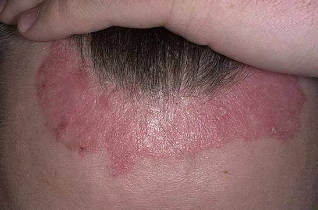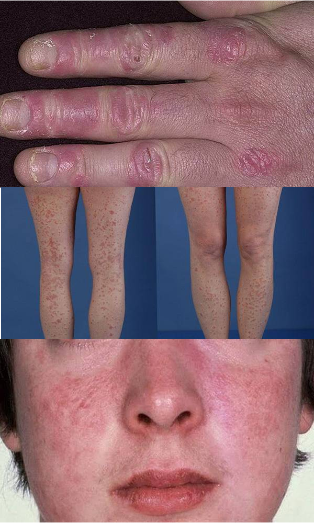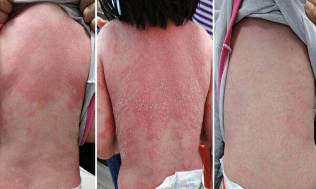Psoriasis refers to diseases of dermatological nature, which is difficult to treat, especially if we are talking about the later stages of the disease. For the timely diagnosis of the disease is important to recognize the psoriasis is at its initial stage. Quick response to the problem and start the timely treatment of the disease, you can prevent many of the complications of the disease in the future.

How does psoriasis at the initial stage
On the skin often appear rash of a different nature. The rash can occur due to allergic reactions, damage to the skin, but there are certain symptoms that should alert every human being. These include:
- The development of bright red or pink spots with clear boundaries. If precipitation appeared due to damage to the dermis, for example, after scratches, burns, you should immediately make an appointment with a dermatologist.
- Spots begin to peel and itch. Such signs likely to indicate the development of psoriasis.
- Itching is not always inherent to the disease, therefore, even the usual red spots on the body should be cause for seeking medical attention.
For the initial stages of the pathology is characterized by the appearance of lesions of a small diameter. When the disease in the form of drops, the diameter of plaques the size of a match head. Psoriasis vulgaris is accompanied with papules, larger. The spots reach a diameter of the coin 5 cents, rapidly progressing, merge with each other.
Special attention should be paid to the colour and character of peeling. In psoriasis, dead skin may have white or brownish hue. When you try to scrape off the scales in most cases peeling is enhanced.
Understanding, how does the beginning of psoriasis, should consider this phenomenon when the disease like psoriatic triad. A triad is a set of symptoms which likely indicate the presence of psoriasis in humans. Its major manifestations include 3 stages:
- Stearic spot - the appearance of the site, nestled small silvery white scales. When you remove the peeling is enhanced. This phenomenon has received the name due to similarity of appearance with Stearin.
- Terminal film - after removing flaky skin, under it is found a smooth, thin surface, the so-called terminal film. The skin in this place is very thin, easily damaged.
- Bloody Rosa - the bleeding appears when the film is damaged. Often minor bleeding, the drops are on the sides of the spots.
The initial stage of the disease lasts from several days to several weeks. Work-in-progress pathology is rapidly evolving, plaques increase in number, the rash affects large areas.
To prevent the disease is important to seek qualified medical help in the first stages of the pathology.
How does psoriasis on the head

Many people wonder how does psoriasis on the head? At the initial stage of psoriasis scalp appears in the form of a slight peeling at the hairline and on the scalp. Over time the peeling becomes stronger, appear characteristic for the disease papules, which itch and cause the patient considerable discomfort. The dermis in the affected areas is compacted, it hurts. The hair does not fall out, as the lesion affects only the upper layers of the epidermis, not affecting the hair follicles.
Psoriasis of the scalp often accompanied by complication such as the accession of bacterial and fungal infection. This condition requires immediate medical treatment, as often entails serious health problems.
Looks like psoriasis on the body
The nature of psoriatic lesions depends on the type of disease. Plaques most often appear in areas of friction skin. These are areas like elbows, knees, hands, feet, groin, armpits. Consider the typical symptoms for certain diseases:
- Teardrop psoriasis is accompanied by the appearance of spots of small diameter, similar in appearance with drops. For this type of disease is not always characterized by the peeling and itching.
- Tabula is the most common type of pathology that is accompanied by the appearance on the dermis of the spots are quite large in size, are rapidly progressing, merge with each other.
- Pustular severe form of the disease, which is characterized by the appearance of plaques filled with purulent exudo. Pustular form requires immediate treatment, as it carries a greater risk of developing psoriatic erythroderma.
- psoriatic erythroderma is a very dangerous condition that occurs due to improper or delayed treatment of other forms of pathology. While psoriatic spots hiding large areas of skin. Erythroderma often provokes severe consequences and even death.
- Psoriasis on the nails - the external manifestations of pathology very similar to that of nail fungus. In this case the nail plate is distorted, compacted, loses its natural Shine. Often there is a loss of the nails.

There are atypical forms of psoriasis. When symptoms of the disease very difficult to diagnose even for an experienced specialist. Do not attempt to establish the diagnosis at home.
How does psoriasis on the hands
Psoriasis on the hands also depends on the form of pathology. Most of the spots occur on the palms, between your fingers. In order not to confuse psoriasis with other skin conditions, it is important to make an appointment with a dermatologist.
How does psoriasis on the legs
Most often rash on legs appear in the form of small papules that occur on the feet, knees. Plaque quickly spread across the surface of the feet. Feet and knees are not the only localization of the plaques. The rash can occur anywhere.
How does psoriasis on the face
Often, the disease affects a person's face. Plaques can appear on the forehead, chin, cheeks, eyelids, in the region of the nasolabial folds and even the mouth.

Spots have single or multiple form of plaques depends on the type of pathology. Often psoriasis on the face is the result of a lesion of the scalp. Psoriasis on the face is a very unpleasant as this part of the body is constantly on view.
Looks like Palmar-plantar psoriasis
Palmar-plantar psoriasis is one of the most common forms of pathology, as it is the palm and feet lend themselves to continuous friction and frequent mechanical damage. The characteristic symptoms of this type is a process in which the skin becomes more rough, the appearance of blisters, peeling. Many patients are not in a hurry to go to the doctor, considering the condition of the skin normal because of his work.
Complicated by Palmar-plantar psoriasis due to frequent damage of plaques in which the skin cracked, bleeds often associated bacterial infection.
In order to prevent such complications, it is important to begin treatment of disease.

Looks like psoriasis in children
Children psoriasis is quite rare. Rashes in children are often confused covered in a rash and other dermatitis. To diagnose the presence of pathology in a child may exceptionally qualified specialist, because children psoriasis often occurs in an atypical form.
Psoriasis in child may occur at any age. Plaques appear on the same places as in adults, but not always accompanied by flaking and itching. Rare acts in children psoriasis of the scalp. According to statistics this type, the child develops after 10 years.
In order to prevent complications of the disease, it is necessary to show the child the doctor when even minor lesions on the body.
The treatment of psoriasis
Treatment of the disease always depend on the type of pathology and its flow. In the initial stages, patients often administered funds in the form of ointments, designed for topical application. In most cases the use of the following medications:
- salicylic ointment;
- sulfur;
- zinc paste;
- ointment on the basis solidol;
- tar ointment.

In acute course of the disease and lose substantial sections of dermis, doctors prescribe drugs on the hormonal basis.
Of particular importance in the treatment is physical therapy. To popular physiotherapy treatment include:
- Electrosleep.
- Ultraviolet irradiation.
- PUVA-therapy.
- X-ray treatments.
- Magnetotherapy.
- The laser treatment.
- Diadynamic therapy.
- Selective therapy.
Good effect in the treatment pathology gives mud and stay in conditions of sanatoriums.
Psoriasis is a severe disease that require correct and timely treatment. Unfortunately, today is not open methods that can completely save people from the disease. To achieve stable remission is possible by the combination of a number of therapeutic measures and a healthy lifestyle. Attentive to their health and to observe all doctor's instructions will keep your skin in good condition and avoid the many negative consequences in the future.























